Yicheng He
Optimizing NeRF-based SLAM with Trajectory Smoothness Constraints
Oct 11, 2024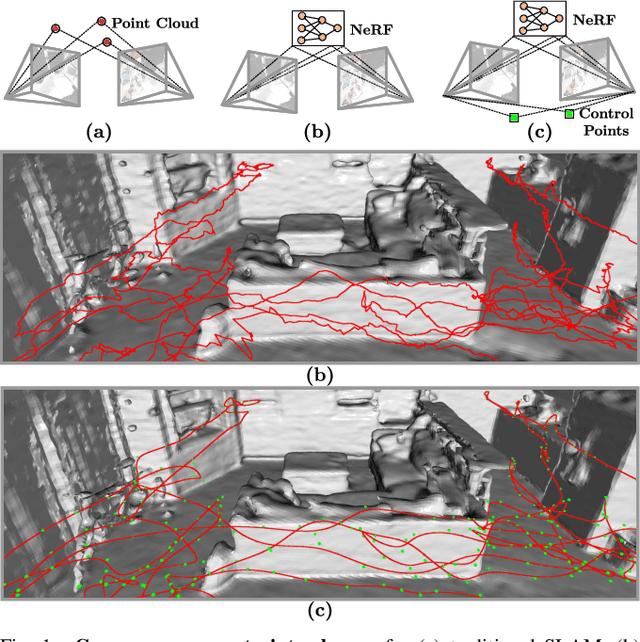
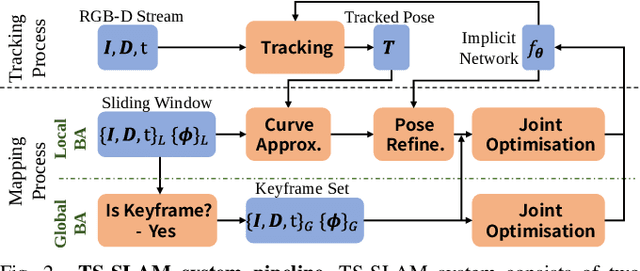
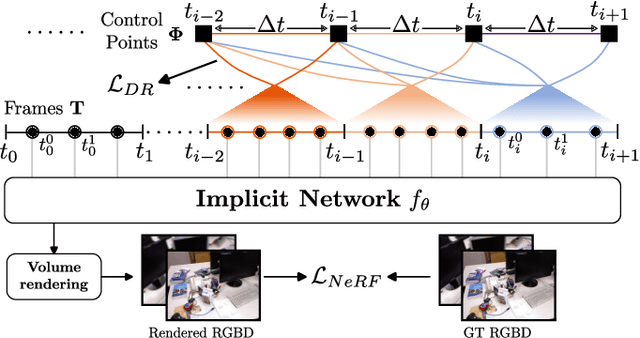
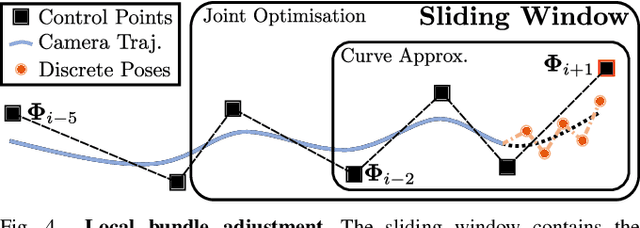
Abstract:The joint optimization of Neural Radiance Fields (NeRF) and camera trajectories has been widely applied in SLAM tasks due to its superior dense mapping quality and consistency. NeRF-based SLAM learns camera poses using constraints by implicit map representation. A widely observed phenomenon that results from the constraints of this form is jerky and physically unrealistic estimated camera motion, which in turn affects the map quality. To address this deficiency of current NeRF-based SLAM, we propose in this paper TS-SLAM (TS for Trajectory Smoothness). It introduces smoothness constraints on camera trajectories by representing them with uniform cubic B-splines with continuous acceleration that guarantees smooth camera motion. Benefiting from the differentiability and local control properties of B-splines, TS-SLAM can incrementally learn the control points end-to-end using a sliding window paradigm. Additionally, we regularize camera trajectories by exploiting the dynamics prior to further smooth trajectories. Experimental results demonstrate that TS-SLAM achieves superior trajectory accuracy and improves mapping quality versus NeRF-based SLAM that does not employ the above smoothness constraints.
PISR: Polarimetric Neural Implicit Surface Reconstruction for Textureless and Specular Objects
Sep 22, 2024Abstract:Neural implicit surface reconstruction has achieved remarkable progress recently. Despite resorting to complex radiance modeling, state-of-the-art methods still struggle with textureless and specular surfaces. Different from RGB images, polarization images can provide direct constraints on the azimuth angles of the surface normals. In this paper, we present PISR, a novel method that utilizes a geometrically accurate polarimetric loss to refine shape independently of appearance. In addition, PISR smooths surface normals in image space to eliminate severe shape distortions and leverages the hash-grid-based neural signed distance function to accelerate the reconstruction. Experimental results demonstrate that PISR achieves higher accuracy and robustness, with an L1 Chamfer distance of 0.5 mm and an F-score of 99.5% at 1 mm, while converging 4~30 times faster than previous polarimetric surface reconstruction methods.
Dataset Bias Mitigation in Multiple-Choice Visual Question Answering and Beyond
Oct 31, 2023Abstract:Vision-language (VL) understanding tasks evaluate models' comprehension of complex visual scenes through multiple-choice questions. However, we have identified two dataset biases that models can exploit as shortcuts to resolve various VL tasks correctly without proper understanding. The first type of dataset bias is \emph{Unbalanced Matching} bias, where the correct answer overlaps the question and image more than the incorrect answers. The second type of dataset bias is \emph{Distractor Similarity} bias, where incorrect answers are overly dissimilar to the correct answer but significantly similar to other incorrect answers within the same sample. To address these dataset biases, we first propose Adversarial Data Synthesis (ADS) to generate synthetic training and debiased evaluation data. We then introduce Intra-sample Counterfactual Training (ICT) to assist models in utilizing the synthesized training data, particularly the counterfactual data, via focusing on intra-sample differentiation. Extensive experiments demonstrate the effectiveness of ADS and ICT in consistently improving model performance across different benchmarks, even in domain-shifted scenarios.
* EMNLP 2023
Understanding ME? Multimodal Evaluation for Fine-grained Visual Commonsense
Nov 10, 2022Abstract:Visual commonsense understanding requires Vision Language (VL) models to not only understand image and text but also cross-reference in-between to fully integrate and achieve comprehension of the visual scene described. Recently, various approaches have been developed and have achieved high performance on visual commonsense benchmarks. However, it is unclear whether the models really understand the visual scene and underlying commonsense knowledge due to limited evaluation data resources. To provide an in-depth analysis, we present a Multimodal Evaluation (ME) pipeline to automatically generate question-answer pairs to test models' understanding of the visual scene, text, and related knowledge. We then take a step further to show that training with the ME data boosts the model's performance in standard VCR evaluation. Lastly, our in-depth analysis and comparison reveal interesting findings: (1) semantically low-level information can assist the learning of high-level information but not the opposite; (2) visual information is generally under utilization compared with text.
Query Adaptive Few-Shot Object Detection with Heterogeneous Graph Convolutional Networks
Dec 17, 2021



Abstract:Few-shot object detection (FSOD) aims to detect never-seen objects using few examples. This field sees recent improvement owing to the meta-learning techniques by learning how to match between the query image and few-shot class examples, such that the learned model can generalize to few-shot novel classes. However, currently, most of the meta-learning-based methods perform pairwise matching between query image regions (usually proposals) and novel classes separately, therefore failing to take into account multiple relationships among them. In this paper, we propose a novel FSOD model using heterogeneous graph convolutional networks. Through efficient message passing among all the proposal and class nodes with three different types of edges, we could obtain context-aware proposal features and query-adaptive, multiclass-enhanced prototype representations for each class, which could help promote the pairwise matching and improve final FSOD accuracy. Extensive experimental results show that our proposed model, denoted as QA-FewDet, outperforms the current state-of-the-art approaches on the PASCAL VOC and MSCOCO FSOD benchmarks under different shots and evaluation metrics.
Meta Faster R-CNN: Towards Accurate Few-Shot Object Detection with Attentive Feature Alignment
Apr 15, 2021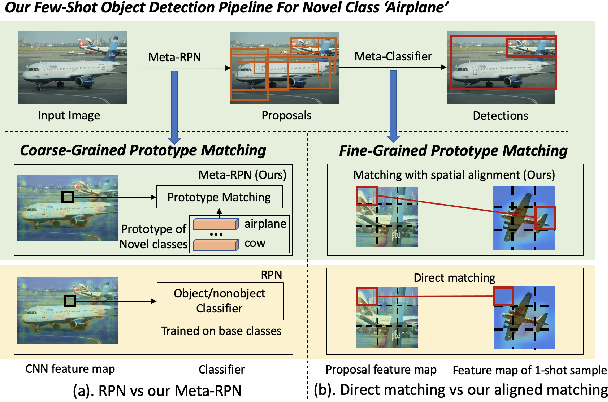

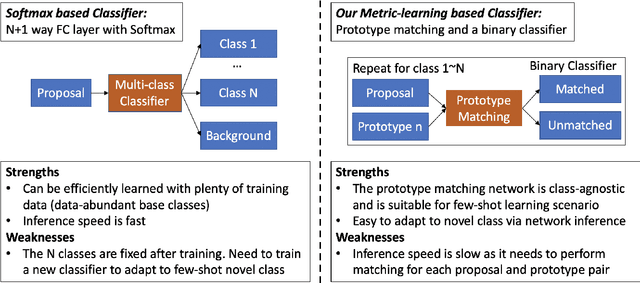

Abstract:Few-shot object detection (FSOD) aims to detect objects using only few examples. It's critically needed for many practical applications but so far remains challenging. We propose a meta-learning based few-shot object detection method by transferring meta-knowledge learned from data-abundant base classes to data-scarce novel classes. Our method incorporates a coarse-to-fine approach into the proposal based object detection framework and integrates prototype based classifiers into both the proposal generation and classification stages. To improve proposal generation for few-shot novel classes, we propose to learn a lightweight matching network to measure the similarity between each spatial position in the query image feature map and spatially-pooled class features, instead of the traditional object/nonobject classifier, thus generating category-specific proposals and improving proposal recall for novel classes. To address the spatial misalignment between generated proposals and few-shot class examples, we propose a novel attentive feature alignment method, thus improving the performance of few-shot object detection. Meanwhile we jointly learn a Faster R-CNN detection head for base classes. Extensive experiments conducted on multiple FSOD benchmarks show our proposed approach achieves state of the art results under (incremental) few-shot learning settings.
Drug Selection via Joint Push and Learning to Rank
May 18, 2018



Abstract:Selecting the right drugs for the right patients is a primary goal of precision medicine. In this manuscript, we consider the problem of cancer drug selection in a learning-to-rank framework. We have formulated the cancer drug selection problem as to accurately predicting 1). the ranking positions of sensitive drugs and 2). the ranking orders among sensitive drugs in cancer cell lines based on their responses to cancer drugs. We have developed a new learning-to-rank method, denoted as pLETORg , that predicts drug ranking structures in each cell line via using drug latent vectors and cell line latent vectors. The pLETORg method learns such latent vectors through explicitly enforcing that, in the drug ranking list of each cell line, the sensitive drugs are pushed above insensitive drugs, and meanwhile the ranking orders among sensitive drugs are correct. Genomics information on cell lines is leveraged in learning the latent vectors. Our experimental results on a benchmark cell line-drug response dataset demonstrate that the new pLETORg significantly outperforms the state-of-the-art method in prioritizing new sensitive drugs.
 Add to Chrome
Add to Chrome Add to Firefox
Add to Firefox Add to Edge
Add to Edge